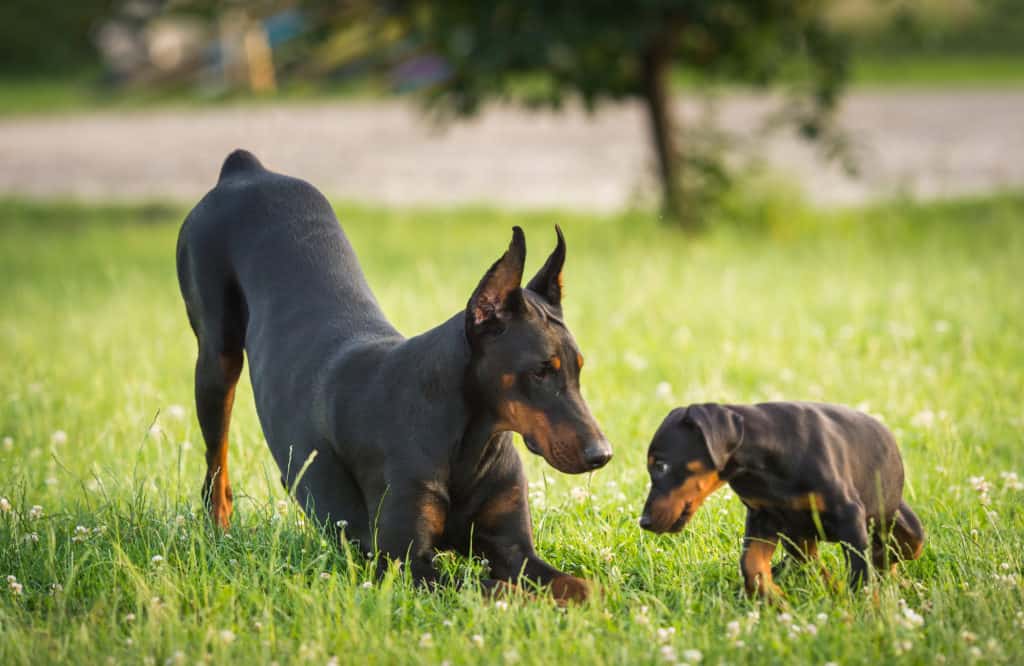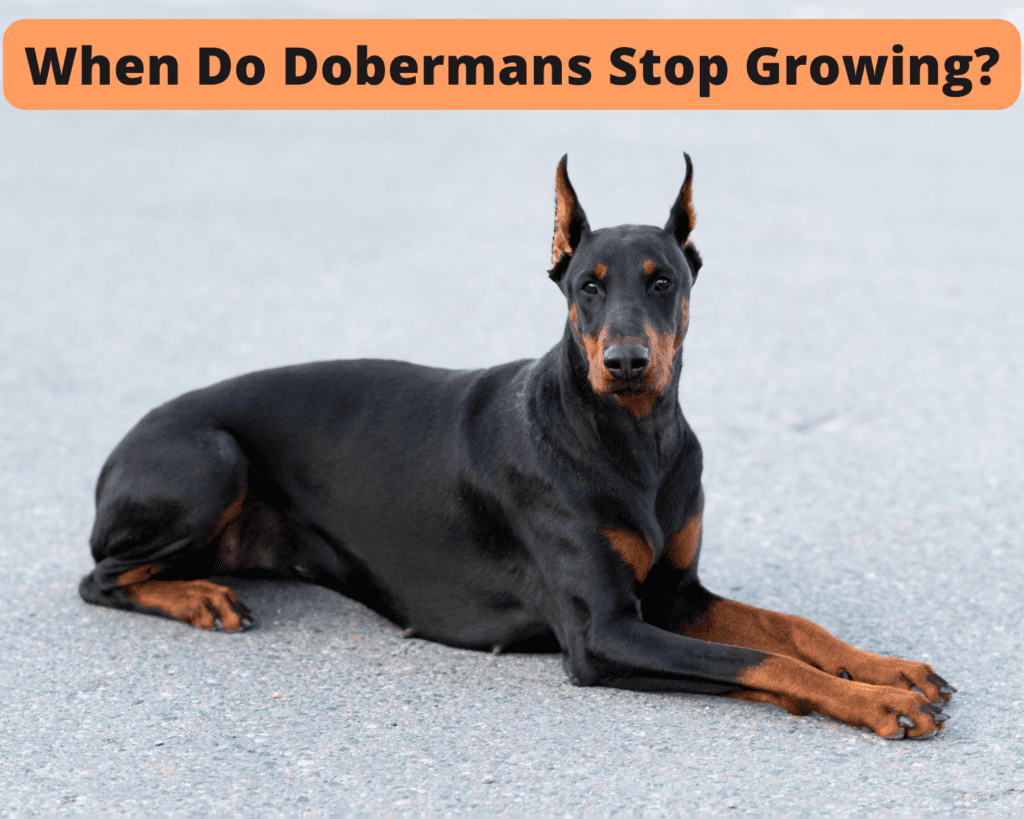Dobermans are a majestic working dog breed, renowned for their strength and unmistakably sleek appearance.
If you have a Doberman, then you’re probably expecting them to grow to a fairly large size – but how big will they become?
When do Dobermans stop growing? Read on to find out!
What Age Does A Doberman Stop Growing?
A Doberman usually stops growing in height at around one year of age. Though they can reach their full height at one year old, most Dobermans will continue to thicken and gain weight for an additional year.
This timeframe can vary some between individual dogs as every dog is different. Some members of the breed even continue gaining height until they’re 24 months old.
Normally, females stop growing sooner than males, but the discrepancy is not overly significant.
Doberman Sizing And Physical Characteristics
Dobermans are considered a large dog breed. They have a well-known, easily recognized silhouette and are renowned for being rather intimidating in appearance.
A healthy Doberman is slender and lean in build, with a lot of muscle for a powerful and athletic body. Their bodies have a solid color with coats in shades of black, fawn, blue, or red, marked with tan.
They are further decorated with brown splotches over their legs, feet, eyes, and muzzles, and they have dark eyes.
Dobermans are also fairly well-known for their docked tails and cropped ears.
The practice of altering the dogs in this way is controversial, and it’s a good idea to speak to a vet and do your own research before deciding if your Doberman will receive these procedures.
A Doberman’s Adult Size
Many Dobermans reach a stable weight and size at approximately 18 months of age. This is the point at which their weights and heights are mostly stable.
This is because their joints are fully formed at this juncture. They may continue to grow slightly, but not by much, as their frames have been filled out.
Male Dobermans are considered in their prime at the age of three years. Meanwhile, female Dobermans are in their prime at the age of anywhere from two to three years.
The American Doberman’s adult weight ranges from 60 to 90 pounds for females and 75 to 100 pounds for males.
On the other hand, the European Doberman’s adult weight ranges from 71 to 77 pounds for females and 88 to 99 pounds for males.
It’s worth noting, though, that the aforementioned weights are descriptions of the breed standard. This means that individual dogs may differ from those expectations.
Those outside the breed standard are still normal Dobermans, they just can’t participate in official shows.
In fact, the breed standards rarely reflect an accurate example of all dogs.
Doberman Growth Chart By Age And Sex
| Age (months) | Male Weight (pounds/lbs) | Female Weight (pounds/lbs) |
|---|---|---|
| 2 | 19 - 21 | 15 - 17 |
| 3 | 29 - 32 | 25 - 27 |
| 4 | 39 - 41 | 34 - 36 |
| 5 | 49 - 50 | 43 - 44 |
| 6 | 59 - 60 | 50 - 51 |
| 7 | 65 - 66 | 55 - 56 |
| 8 | 69 - 70 | 59 - 60 |
| 9 | 74 - 75 | 64- 65 |
| 10 | 78 - 79 | 67 - 68 |
| 11 | 80 - 81 | 69 - 70 |
| 12 | 83 - 84 | 71 - 72 |
| 24 | 87 - 88 | 74 - 75 |
Different Growth Stages For Dobermans
1. Newborn
The newborn or neonatal stage constitutes the point from birth to two weeks of life. Like all puppies, Dobermans are born with their eyes closed. They also have their ears tightly creased.
Newborns of this breed experience a lot of rapid growth and will be nursing pretty much constantly – every hour or every other hour – to support that.
At this stage, it is important to handle the dogs so they imprint correctly.
2. Transitional
The transitional phase of puppyhood is fairly short, lasting for the ages of 15 to 21 days, or 2 to 3 weeks. This is why the ears and eyes of a puppy open up and start to sharpen.
A Doberman at this age may startle easily as it gets used to the world around it and the sensory input from everywhere.
Dogs, at this point, will become very sensitive to their environment as they undergo a lot of neurological growth.
All their senses will be properly functional by the end of this stage.
3. Socialization
A puppy’s period of socialization lasts from their third to twelfth weeks of life. There are technically two socialization periods, namely primary socialization and secondary socialization.
The former is where dogs learn to socialize with other dogs, and the latter is when they do so with humans.
This extremely crucial stage is when puppies learn the social skills that they’ll take with them as they continue to socialize for the rest of their lives.

The primary socialization phase lasts up to week 7 approximately. Puppies here will begin to play with their siblings and take part in coordinated group action. Your dog must be kept with their mother and litter at this juncture.
At 3 weeks, most puppies can walk on their own. By the time they’re 6 weeks old, Doberman puppies are typically fully weaned, which gives them even more freedom.
The secondary phase picks up in week 8 and goes on to the end of this growth stage. This is the best time to let a Doberman puppy meet as many humans as possible, as well as experience new environments.
Exposure to humans before this age is, of course, highly recommended, but this is when that gets solidified.
4. Juvenile
Juvenile Doberman puppies have emerged from their states of the most rapid growth. This is more of a period of gradual growth as their motor skills mature. The phase lasts from the ages of 3 to 6 months.
This is also the point where Doberman owners will have to start watching their dogs’ weights. At about 5 months of age, most dogs of this breed will be eating two meals a day instead of 3 or 4, with a few snacks now and then.
At the end of this stage, Dobermans will have almost all of their permanent teeth.
Spaying and neutering may also be done at the end of the juvenile period, but you should speak to your vet about the exact timeframe that they recommend.
5. Adolescent
Adolescence for Dobermans runs from 7 months to 12 months of age. Female Dobermans usually reach their full height at this stage and may experience their first heat.
Regardless of sex, these dogs mature continually throughout this growth phase in slower, steadier ways.
6. Adult
Once a Doberman is one-year-old, they are considered an adult. But this is not to say that all their growth is done!
Both mental and physical characteristics will continue to mature for the next one or two years before settling for good at 2 to 3 years of age.
Dobermans reach a “senior” adulthood stage at the relatively young age of 7 years, and most dogs of this breed live to be about 9 to 12 years old.
Conclusion
Dobermans are big dogs, but they grow pretty quickly and reach an adult height and weight at a fairly young age. Expect a lot of rapid growth – they’ll go from tiny to large in a short span of time!

